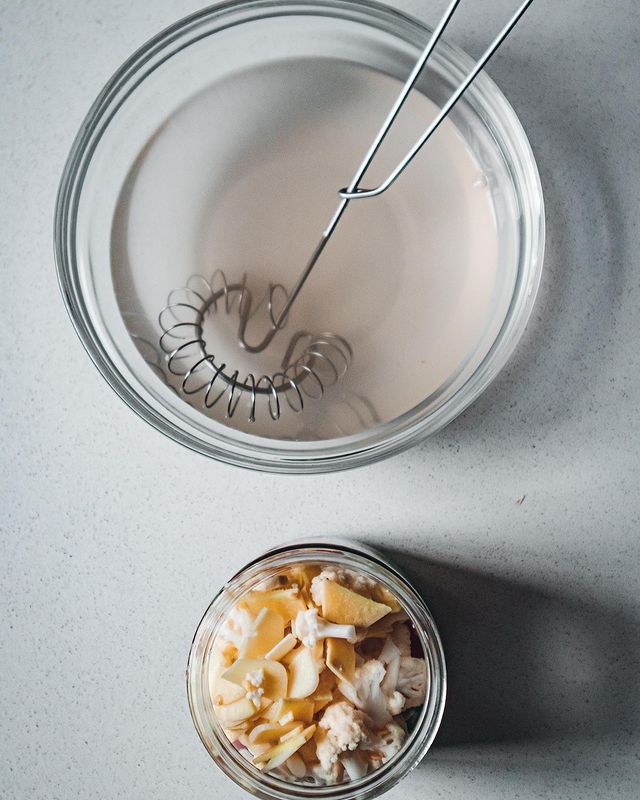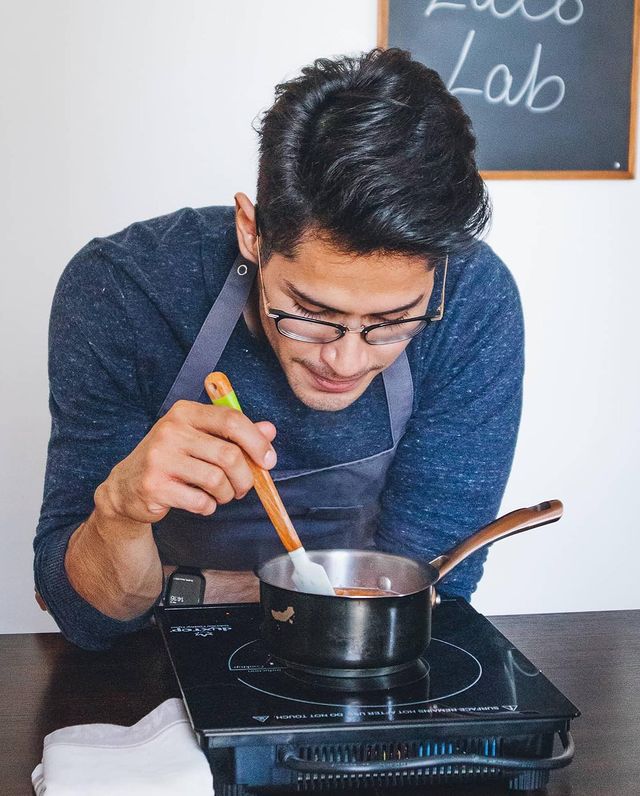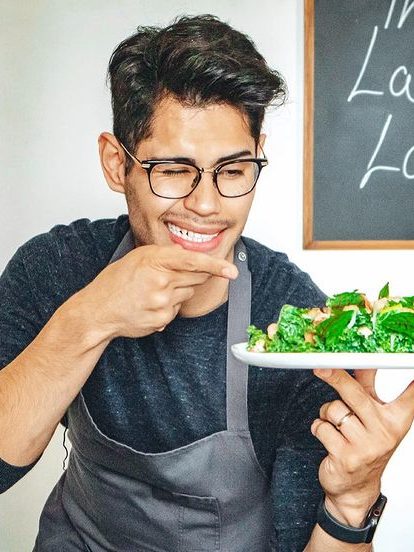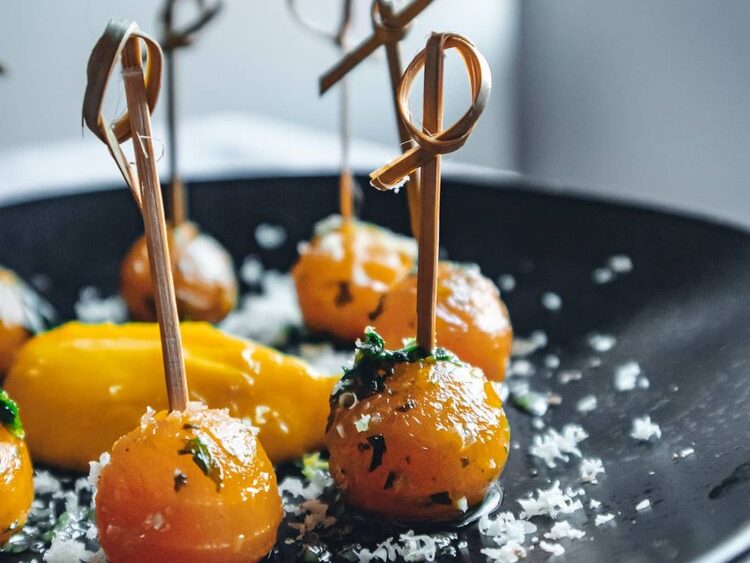Have you ever felt frustrated when you open your fridge and only see vegetables?
I certainly have.
The reason is that most of tend to see vegetables as just a side dish and, because of that, don’t know how to really cook with them.
I didn’t — at least not until I went to culinary school!.
I always tell people that cooking should be fun. It’s not always easy, but it should definitely always be a pleasant experience — whether by yourself or with your family or loved ones. At the end of the day, cooking is a creative process and, whether you realize it or not, let me be the one to tell you that you definitely are creative!
It is actually this lack of creative awareness that causes many people to miss the beauty of cooking with vegetables. You may even think that vegetables are boring and tasteless (we’ve all heard the term “rabbit food”!). But those who think plant-based eating is drab just haven’t seen or tasted all the beautiful, flavorful, and satisfying things you can make with vegetables.
That’s about to change!
The world of vegetables is vast and colorful, and so much more interesting than pieces of meat. Vegetables come in all shapes, sizes, textures, and flavors, and there are so many different kinds for you to discover and play with as you explore your cooking creativity.
Changing How You Look at Vegetables
Of course, knowing what you’re doing is a significant contributor to making any sort of cooking enjoyable.
That’s why I suggest that, first and foremost, you learn the basics of cooking. Not only will it lead to a smoother, more pleasant experience every time you make something to eat (plant-based or not), but it’s a fundamental life skill.
After all, the more we learn something, the more confident we become.
If you’re not used to cooking with vegetables or not used to using them in complex ways, it’s important to think of them differently than you have in the past.
To help illustrate what I mean, let me take you through the five-step thinking process I use as a vegan chef when it comes to cooking vegetables:
Step 1: Focus on the Ingredient at Hand
First, stop thinking about meat — or fake meat for that matter. I am not against creating vegan versions of non-vegan dishes, but the problem with this mindset is that when you don’t have an ingredient from the original recipe you get stuck and discouraged because you don’t know how to replace it.
Vegetables deserve as much respect as any protein, and it’s time to think of them as the main act of the dish, rather than the background dancers. This focus applies not only to the way we cook them, but in the way we learn about them, and in exploring all the things we can do with them. So step one is to focus on the vegetable.

Step 2: Think About Cooking Techniques
Second, ask yourself, “What cooking techniques do I know?”
This is a very important point because you’re only as creative as the cooking techniques you know how to use. If you only know how to steam vegetables, for example, it’s no wonder you think vegetables are boring and tasteless.
The key here, of course, is to learn as many different cooking techniques as possible. For example, you can sauté, roast, pickle, pan-sear, shallow-fry, deep-fry, dehydrate, purée, and ferment vegetables.
The goal is to get to the point where you can look at a kabocha squash on your kitchen counter and think “I know how to boil, deep fry, pickle and purée this. Which will I use?”

To take this kabocha squash as an example, you might decide to boil it first and leave it slightly under-cooked, then cover it in breadcrumbs and finish it off in the fryer. You’ll have a beautiful crunchy-on-the-outside-but-soft-in-the-middle kabocha squash using two different cooking techniques.
But it’s important to know that you’re not going to learn everything at the same time, so there’s no reason to get overwhelmed.
Knowing a variety of different cooking techniques is the end goal, but to get there you have to take it step-by-step. Stick to one or two techniques in the beginning, and then practice, practice, practice.
Practicing, experimenting, learning through trial and error, and refining is the key to mastering anything in the kitchen (and in life!). Once you’ve got one down, you can move on to another technique, and so on.
Step 3: Think About the Best Techniques for the Ingredients You’re Using
If you have several techniques in your tool belt, think, “what technique will help me achieve the texture I want?” and then, “does this technique make the most out of the ingredient I have?”
If the answer to the second question is yes, then go ahead with it. If not, then you might want to think it over again. Is there another technique that would make the most out of it? Try something else, or you can even use two techniques that’ll help you achieve the result you want, like in the kabocha squash example above.

Step 4: Cook, Experiment and Fail
Now, it’s time to cook! Here’s where you get to apply the techniques you’ve learnt and which you’ve decided are the best for your ingredients.
Naturally, there will be times when you fail and don’t get the result you want — that’s ok. In fact, it’s good because it means you’re learning and experimenting.
So, just cook and don’t worry about failure! Failure is necessary for growth and the only way you’re going to become a better cook is to cook more often.

Step 5: Enjoy Your Hard Work, Be Proud of Yourself and Never Stop Learning
Finally, enjoy what you make. After all, the best part about cooking is that you get to eat your result! Be proud of yourself — even if you fail. This last bit is critical because your attitude will determine whether you try again or not. And remember, just the fact that you tried at all is a success.

How I Put This Approach Into Practice
Reading through the process is one thing, but I think it’s easier to understand if you can see how I apply it myself. Here’s an example of how I applied it to create a golden beet dish with beet purée and parsley pesto.
This dish is a perfect example of how to create a plate around a vegetable instead of thinking about how to replace any dairy or meat. I wanted to take advantage of the beautiful golden beets from the farmer’s market and show off their vibrant yellow color, texture, and shape.
I thought about roasting the beets (because roasted beets are delicious) or boiling them if I wanted to cook with less oil. I could have also added them to a raw salad or pickled them. But in the end, I decided to cut them into spheres and glaze them, and then make a purée out of the trims.
Roasting beets brings out their sweetness, so that was my first thought, but I wanted to do something different that would still get that soft, succulent inside that you get with roasting. And, I wanted to add more flavor.
So, I decided to sear them first, then added a sweetener (maple syrup) to the pan, and then some vegetable broth, which is what the beets absorb. All that liquid is reduced and concentrated in the pan and sticks to the beet.
I didn’t add a lot of maple syrup, since the beets were already sweet themselves, but the little I did use created a beautiful shine on the outside of the spheres. The result was beautiful shiny spheres that were packed with flavor.
I also wanted to change the shape of the beets and make them a lot more interesting than your typical beet wedges or rounds, so I decided to use a melon baller to cut them into spheres. I knew from experience that whenever you cut anything into spheres there tends to be a lot of waste, so I decided to do something with those trims instead of throwing them away.
I repurposed them by steaming them and then blending them into a purée to not only add another texture to the plate (creaminess) but also present the flavor of the beet in another form: steamed. I also added a bright, flavorful, aromatic pesto to lift all the flavors up and bring everything together.

Embracing Your Vegetable Creativity
I didn’t follow a recipe for this dish. I just followed my intuition and had fun creating it, while stepping through the five steps of the process I outlined.
I like the feeling of uncertainty, of not knowing what the final result will be, but knowing that I’ll get there. In this case, I didn’t have an end in mind, I just started cooking and the dish came out like it did.
It was pretty solid in flavor and balance, and the purée was smooth and creamy (I didn’t have to add nuts or seeds to it to add creaminess) and the glazed beets were absolutely delicious!
(You can get the recipe, plus a longer description of this dish by clicking here.)
One final note on this dish: a big reason the reason it turned out so great is because of the quality of the vegetable broth and the beets themselves — starting with quality ingredients is always key!
I hope that this process will help you change the way you think about cooking vegetables, and that it helps to make it a fun experience. Let yourself be inspired by nature, and by the fruits and vegetables of the Earth — they are the ultimate masterpieces!
And don’t forget to relax, open your mind to the infinite possibilities, and enjoy the moment you’re taking to nourish yourself and others.
Finally, always remember this: the energy that you put into your cooking is the energy you will receive when you eat it.
All images courtesy of The Lalo Lab.
